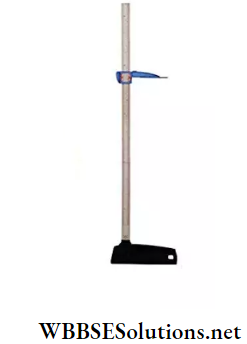Chapter 5 Measurement Necessity Of Measurement In Our Daily Life & Units Of Measurement
Think of the following very common situations in your day-to-day life. Let us suppose that you have come to a store to buy a new dress material for you.
After making the perfect choice for yourself the next thing that you need to do is to decide how much cloth do you require to buy for your dress.
Again suppose, for the time being, that you are ill and you need to take your medicine. You would definitely appreciate the fact that you have to take it in the proper amount.
If you take too little or too much then you are not going to get the proper benefit out of it.
Coming to a different issue-have you ever thought about how often and why do you glance at your watch or the wall clock in your home each day?
Read And Learn More: WBBSE Notes For Class 6 School Science
All the above issues relate to measurements. We all make measurements every day of our lives.
Measurement has been important ever since man settled from his nomadic lifestyle and started making houses, occupying land and trading with his neighbours.
As society has become more and more advanced, we have either consciously or unconsciously become habituated to carrying out measurements in our daily life or have become surrounded by the outputs of various measuring devices which make our life simple.
Before going in for the definition of measurement, let us pay our attention to the simple facts again as discussed above.
Suppose that you have bought 2 metres of cloth for your 80 dress material and that a pill or medicine contains 200 milligrams of chemicals.
Again, say, you saw that it was 6 PM in the evening when you started studying and 10 PM at night when you finished it off. That means you have studied for 4 hours in the evening.
Thus, Measurement is the comparison or estimation of an unknown quantity with a known standard quantity (constant quantity) or unit of the same type.
It is expressed as the multiple of a real number and a unit, where the real number is the comparison expressed as a ratio.
An example may be 2 metres of cloth, which is an estimate or comparison of an object’s (here it is cloth) length relative to a standard unit of length, one metre.
Moreover, in the example, 2 is the magnitude of length and ‘metre’ is the standard unit of the physical quantity (here it is long).
Thus in order to express the result of measurement, we should know:
- The unit in which a quantity is to be measured.
- The numerical value expresses how many times a standard quantity or unit is contained in a given physical quantity.
Importance Of Measurement
- Unless we are able to measure some phenomena, we cannot say that we scientifically know anything about that thing. Hence measurement is the key to scientific understanding and analysis.
- Measurement gives a base to understand the universe. All around us, we are surrounded by various things. We might not note it but unconsciously we are actually measuring things to comprehend them in one way or the other.
Chapter 5 Measurement Physical Quantity
Anything that can be measured is called a physical quantity. For example, the length and breadth of a classroom can be measured.
How At this point you would be able to appreciate the fact that how the world would be without being able to measure anything.
It is a fact that we are surrounded by Measurement. measure these quantities. To express a physical quantity, we associated a magnitude with it.
The number of times a standard quantity is present in a given physical quantity is called the magnitude of a physical quantity. Thus, physical quantity = (magnitude) x (unit).
much milk a glass can contain or the volume of milk in a glass can be measured.
So length, breadth, volume, time, mass, etc. are all physical quantities. We need certain instruments to
Chapter 5 Measurement Fundamental And Derived Physical Quantity
From the point of view of measurements, physical quantities are of two types- Fundamental and Derived physical quantities.
There are some physical quantities which do not depend on other physical quantities, e.g. length, mass, time, etc. These physical quantities are called Fundamental Physical Quantities.
However, consider the following physical quantities and the associated formulae to measure them-
Area of rectangle = length x breadth Volume of rectangular box = length x breadth x height Velocity = distance travelled/time taken Density = mass/volume.
It is clear that above mentioned physical quantities have more than one fundamental physical quantity associated with them. Thus we get the idea of Derived Physical Quantities.
There are some physical quantities which are made of more than one fundamental physical quantity, e.g. area, volume, velocity, density, etc.
These physical quantities are called Derived Physical Quantities.
While measuring any physical quantity it is expressed as a multiple of a standard quantity which is contained in the given physical quantity. This standard is called a Unit.
Fundamental Unit The units associated with the fundamental physical quantities are called Fundamental units. These are independent of any other units.
Chapter 5 Measurement Units Of Measurement
From time immemorial, man has been facing the necessity of measuring various quantities. For measuring mass, he used various kinds of standards.
For measuring length, he used foot length or arm length, etc. However, parts of the human body differ in length for different people. This led to a lot of confusion.
Gradually with the passage of time, people accepted certain rules of measurement. It became clear that for accurate measurement of any physical quantity, a unit was necessary.
Without a unit, any measurement is meaningless. Recall from the earlier discussion that we expressed a physical quantity as physical quantity (magnitude) x (unit).
For example, let the length of a book be 20 centimetres. It bears a clear meaning. It means that the said length is 20 (magnitude) times a centimetre (unit).
On the contrary, if it is said that the length is 20, it does not carry any sense.
The following are the fundamental units:
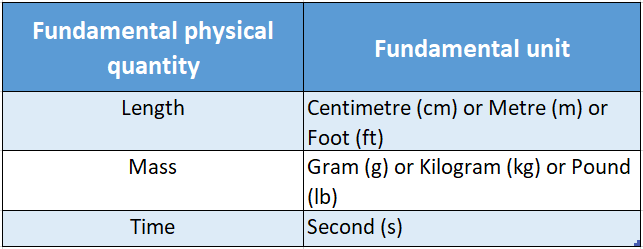
Derived Unit:
The units associated with the derived physical quantities are called Derived units. These are obtained by the combination of one or more fundamental units.
The following are a few examples of Derived units that show how they can be obtained from fundamental units of mass, length and time:
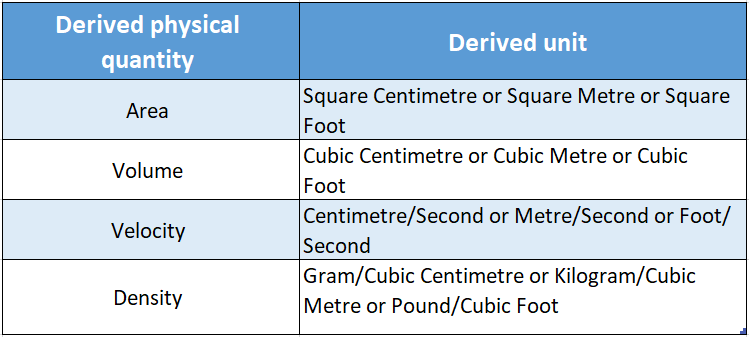
System of Units:
The fundamental units of length, mass and time taken together form a system of units. For measuring various physical quantities following systems are commonly adopted:
CGS system:
In this system, C stands for centimetre (length), G stands for gram (mass) and S stands for second (time).
MKS system:
In this system, M stands for the metre (length), K stands for kilogram (mass) and
S stands for second (time).
Fps System:
In this system, F stands for foot (length), P stands for pound (mass) and 5 stands for second (time).
Si Or International System: In this system, the units for length, mass and time are the same as that of the MKS system.
Nowadays, only the Sl system is in practice. It is an enlarged system encompassing seven elementary units as shown below:
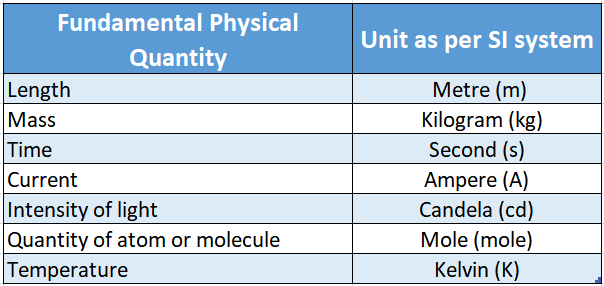
Physical quantities having the same unit:
More than one physical quantity may have the same unit. For example, work and energy are both expressed in Joule.
Physical quantities having no unit:
There are certain physical quantities which are expressed as ratios of two similar physical quantities.
Hence, they have no unit or are unitless physical quantities, e.g. specific gravity (ratio of density), specific heat (ratio of heat), atomic weight (ratio of mass) etc.
Chapter 5 Measurement Measurement Of Length, Area, Volume, Mass And Time Measurement Of Length
For the measurement of length, a fundamental physical quantity, only length is required and involves no other physical quantities.
One of the oldest units of length measurement used in the ancient world was the ‘cubit’ which was the length of the arm from the tip of the finger to the elbow.
This could then be subdivided into shorter units like the foot, hand or finger, added together to make longer units like the stride.
The cubit could vary considerably due to the different sizes of people. Hence, with the
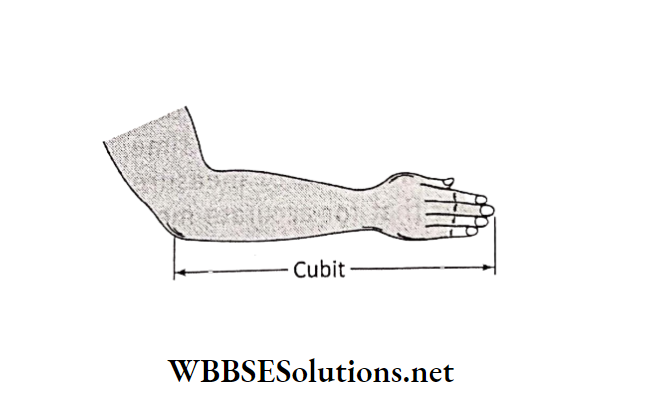
progress of science there was a need for the introduction of standard units to eliminate confusion arising out of the non-standard units of measurement.
The first serious attempt to standardize the unit was made in 1889 in Paris. However, some anomalies were left. In October 1960, another conference was held and the standard units were revised.
Brief characteristics of a standard unit:
- It should be of a convenient size to use.
- It should not change under any circumstances related to space and time.
- It should be possible to be defined without any doubt.
‘Metre’ was chosen to be the unit as per the Sl system of Units or International System of Units for length measurement. In 1791, the Paris Academy of Science defined Metre as under-
One ten-millionth part of the distance from the pole to the equator of the earth is called a metre.
This distance is marked between two parallel lines drawn on a platinum-iridium bar.
This bar is kept at a constant temperature of zero degree centigrade in the International Bureau of Weights and Measures at Sevres near Paris. All replicas of the metre are compared with the standard metre described above.
In 1960, a refinement in the definition of metre was made and it was related to an atomic constant which does not change with time.
Multiples and sub-multiples of Metre :
Not all the lengths to be measured are the same. For instance, we may have to measure the distance from Kolkata to Delhi.
Using metres as the unit, the said distance comes out to be 1305000 metres. Again, say, we need to measure the diameter of a thin wire.
This may be 0.001 metres (say). You find that in both cases using metre is not so convenient. The former one is too large a length and the latter one is too small a length to be measured with a metre as a unit.
Thus there is a need for greater as well as smaller units of length apart from the standard metre.
We can obtain greater units in the SI system by multiplying Metre by 10. These are called Multiple units. Multiples of Metre
Chapter 5 Measurement Measurement Of Area
The area of an object is the quantity that expresses the extent of its shape in a plane. To measure area, we need to measure the length and breadth of the shape or the place with a scale and then have to apply the following formula: Area = length x breadth.
- decametre (dam) = 10 m
- hectometre (hm) = 100 m
- kilometre (km) = 1000 m
Using suitable multiples of metres the expression of longer lengths becomes convenient. Thus the distance from Kolkata to Delhi becomes 1305 km using multiples.
It is interesting to note that to measure very large distances such as those encountered in the solar system or between galaxies, units like the Astronomical unit (AU), Light Year and Parsec are used by scientists.
Parsec is the biggest unit of length. We can obtain smaller units in the Sl system by dividing Metre by 10. These are called sub-multiple units. Sub-multiples of Metre :
- decimetre (dm) = 1/10 m = 10 cm
- centimetre (cm) = 1/100 m = 1 cm
- millimetre (mm) = 1/1000 m = 0.1 cm
Using suitable sub-multiples of metre the expression of smaller lengths becomes convenient. Thus the diameter of the thin wire becomes 1 mm using sub-multiples.
For measurement of very small length, still, smaller sub-multiple like Micron (u), Angstrom (A), Fermi etc. are used.
Note that in the Sl system, each unit is 10 times of its previous unit and 1/10th of its later unit.
This has a tremendous advantage in simplifying computations and conversion of units among multiples and sub-multiples.
Measuring instruments ordinary objects like a glass rod, a piece of cloth etc. are measured directly by comparing them with a scale.
The scale may have different lengths (15 cm, 30 cm, 50 cm, etc.) according to our needs. If the length of the scale is one metre it is called a metre scale. The smallest division of such a scale is 1 mm.

Let us see the application of the above formula to measure the area of a book. The book may be placed on a table and lines are drawn along all sides with a chalk.
After removing the book from the table, the impression made by the chalk mark gives the desired measurement of the length and breadth of the book. Thus the area can be found using the above formula.
For an object shaped like a sphere, cone or cylinder the area of its boundary surface is called the surface area of the object. Let us see how the surface area of a football can be measured.
It is shaped like a sphere. In order to measure the surface area of the ball, its diameter has to be measured first. Two books may be placed on a plane surface touching both sides of the ball.
The distance between the books as measured by a scale gives the diameter of the ball.
Now the surface area of a sphere can be obtained using the following formula Surface area = x diameter x diameter, where π (pronounced as pi) is a number, the value being 3.14.
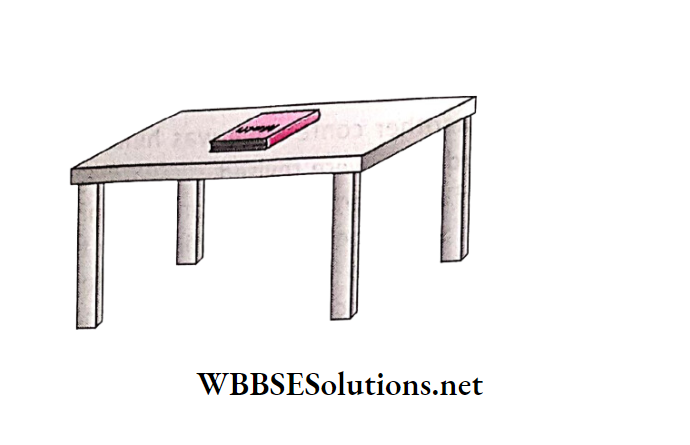
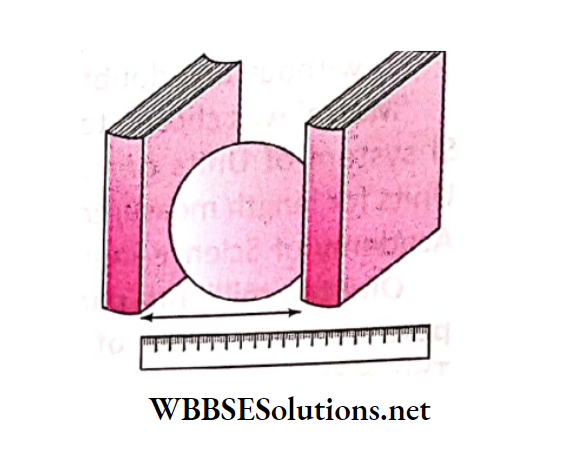
Chapter 5 MeasurementMeasurement Of Volume
Any and every object occupies some space. The space an object occupies is called its volume. Volume is a derived physical quantity. The SI unit of volume is Cubic Metre.
Another unit of volume is the Cubic Centimetre (cc). The volume of liquid is usually expressed in litres (L).
Measuring instrument: A measuring cylinder is employed to measure the volume of a liquid. It is made of glass or some transparent material with a graduation mark or scale (in mL or cc) on its exterior surface along the length.
The range of the measuring cylinder is usually 1 cc to 100 cc. Let us see how we can measure the volume of a certain liquid with it.
A dry measuring cylinder has to be kept in an upright position on the table and the liquid (whose volume is to be measured) shall have to be poured completely into the cylinder.
The liquid will take some time to settle down. When the liquid comes to rest, the graduation mark of the measuring cylinder where the uppermost surface of the liquid touches is to be carefully noted.
This gives directly the measurement of the volume of the liquid.
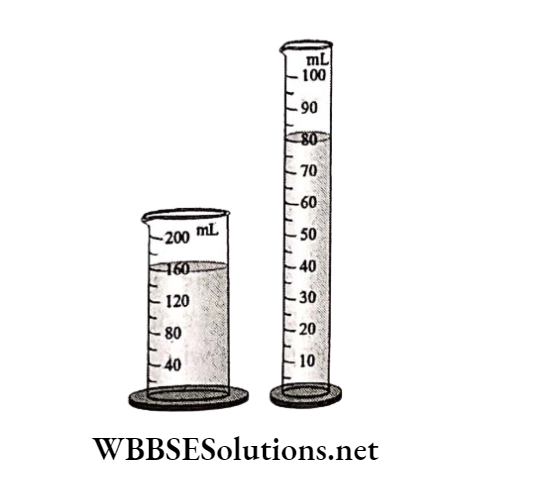
It is to be noted that a measuring cylinder may also be employed to measure the volume of an irregularly shaped solid body, e.g. stone, wooden block, etc.
Since a solid body, when completely immersed in a certain liquid, shall displace a volume of the liquid which is the same as the volume of the solid body itself, so we can measure its volume with the help of the measuring cylinder and a liquid.
Chapter 5 Measurement Measurement Of Mass
The mass of an object is the amount of matter contained in it. It is a fundamental physical quantity.
The SI unit of mass is the kilogram (kg), defined in terms of the mass of a cylinder made of platinum-iridium, the prototype of which is kept at the International Bureau of Weights and Measures at Sevres near Paris.
The CGS unit of mass is gram (g).
Measuring instrument:
A common balance is employed to measure the mass of an object with respect to some known standard mass. The standard masses (or weights) are kept in a weight box.
The substance of unknown mass is to be kept on the left scale pan of the common balance and the standard known masses in the right scale pan.
When the pointer comes to equilibrium, the mass of the substance is measured as equal to the known standard masses.
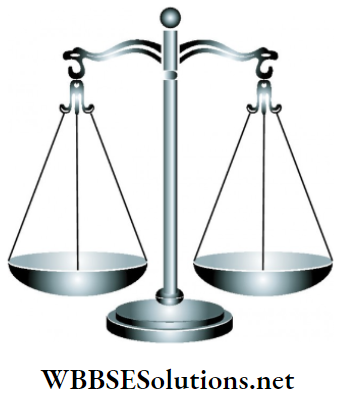
Chapter 5 Measurement Measurement Of Time
You have noticed that there is always an interval between your starting from home and reaching the school after going through the road in the desired direction.
This interval cannot be seen but can be felt. Sometimes the interval increases due to traffic jams and on a few occasions, you reach school early than normal.
This interval is called time. Thus, the interval between any two incidents is called time.
Units of time:
Mean Solar Day:
The average of the varying solar days over a period of 365 days is called the mean solar day. Hour: 1/24th part of the mean solar day is called an hour.
Minute:
The 1/60th part of an hour is called a minute.
Second:
The 1/60th part of a minute is called a second.
Mean Solar Day = 24 hours = 24 x 60 minutes = 1440 minutes = 1440 x 60 seconds = 86400 seconds
Measuring instrument:
A clock or a watch is an instrument used to measure time. It has two hands-one short and one long. Rotation of the long hand between two small marks indicates one minute.
The shorthand shifts one mark indicating one hour. The shorthand completes one total rotation in 12 hours. The use of digital clocks is prevalent nowadays.
It has no hands and shows digits on the screen. It can measure time very precisely. It can even measure time up to 0.01 seconds.
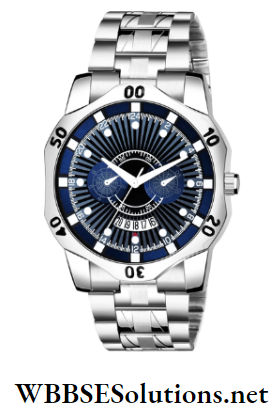
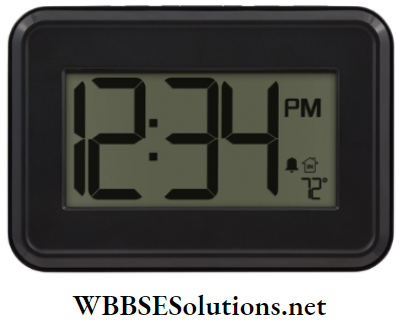
A stopwatch is used to note the time of an event of short duration. It can record 1/5th or even 1/10th of a second.
The longer hand records time in seconds with fractions and the shorter one in minutes. There is a press button which, when pressed, starts the watch and if pressed for the second time, stops the watch.
If again the button is pressed, the second and the minute hands return to their own zero mark.
Thus this watch can be started or stopped by pressing its press button just at the beginning and at the end of an event like a race in sports.
The newest and the most accurate model of the timekeeper is the atomic clock that gains or loses only a second in about 1000 years.
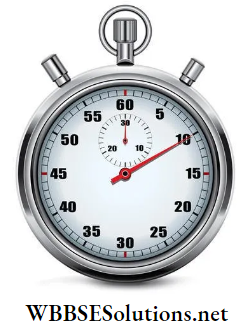
Chapter 5 Measurement Importance Of Estimation In Measurement
Learning how to estimate is a valuable skill. Estimating helps you plan ahead and check your work to see if your answer makes sense.
In our daily life, anybody can be caught in situations when he or she does not have a calculator or other instrument available but needs to make decisions quickly.
He or she can use his or her ability to estimate to get a close answer so that the work can be continued.
Later on, the estimate can be checked back using a calculator or other precise instrument if somebody wishes to do so. Let us discuss some practical situations taken from our daily lives to get the matter clarified.
If you have to be at school at 9 AM sharp, what time do you have to leave in the morning from your home? Often we do not have the exact answer but we need to make an estimation of time which is essentially a guess of measurement.
You have a sense of capacity or volume. Without a clear concept of capacity, you might find yourself pouring an entire half-litre of orange juice into a small glass.
If somebody is unwell, then simply by touching his forehead one can sense whether he has developed a fever or not.
Estimation of body temperature is critical in this regard or else you may land up with wrong conclusions. After some time a thermometer may be used to measure the exact temperature of the body to get a clear picture.
These are simple acts of estimation which is a skill that we all need to practise.
Thus, estimation is the process of finding an estimate or approximation, which is a value that is usable for some purpose even if input data may be incomplete, uncertain or unstable.
The value is nonetheless useful because it is derived from the best information available as per the prevailing circumstances.
The purpose of estimation may be summarized as follows:
1. Estimation helps to plan ahead and check the work to see if an answer makes sense.
2. It provides a rough check of more exact calculations or research results or hypotheses.
3. It helps to obtain approximate knowledge about the quantities when other resources are not available.
4. It helps to obtain approximate knowledge about the quantities that are difficult to measure precisely.
An estimate that turns out to be incorrect will be an overestimate if the estimate exceeds the actual result and an underestimate if the estimate falls short of the actual result.
An informal estimate when little information is available is called a guesstimate because of the inquiry. becomes closer to purely guessing the answer.
Last but not least, though we are forced to do estimation on
quite a few occasions yet it must be remembered that precise measurement is of utmost importance in our life.
Chapter 5 Measurement Measurement Of Plant And Animal Growth
Growth is one of the fundamental features of living organisms. Non-living objects like rocks or crystals may also grow by deposition of new materials, but growth in living things is something distinctly different.
It is a complex phenomenon whereby an increase in size occurs and new tissues are formed. Growth may be
Chapter 5 Measurement Measurement Of Plant Growth
defined as a permanent increase in mass or volume, accompanied by an irreversible change of form or structure. Usually, growth is attended by an increase in weight.
But in germinating seeds or sprouting potato tuber there is a loss of weight during growth, obviously due to utilization of stored food matters.
The rate of growth is imperceptibly slow in plants and so can be hardly detected and measured without the help of a suitable instrument.
Certain plant parts like tendrils of Cucurbit and shoots of bamboo, however, exhibit rapid growth.
Auxanometer is a common instrument used for measuring growth by which the actual growth in length may be magnified many times and conveniently recorded.
A lever auxanometer or arc indicator has a pointer fixed to a wheel and a graduated arc. In a sophisticated auxanometer, the scale is graduated in micrometres.
A cord attached to the growing tip of a potted plant is passed over the wheel and allowed to remain suspended at the other end by a weight.
With the growth of the tip, the indicator moves and the increase is recorded on the graduated arc on a magnified scale. From the record thus obtained the actual increase may be calculated.
If there is a provision to record the time required for this growth, then the rate of plant growth can be measured. The rate of plant’s growth (Measured Growth)/(Recorded Time).
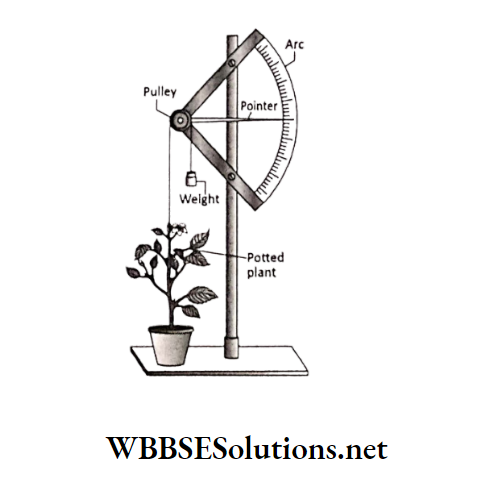
Chapter 5 Measurement Measurement Of Animal Growth
In the case of animals, growth takes place in all parts at a time. However, the rate of growth varies from head to appendages to trunk. Growth never takes place throughout life.
At a certain period, growth stops forever. The instrument and the process to measure the rate of growth are the same for all animals including human beings.
Height is measured on Centimetre Scale. A person has to stand straight in it so that his head touches the indicator fitted to the scale. The reading indicates the height of the person.
Periodic measurements of this kind help to determine the rate of growth of a person.
